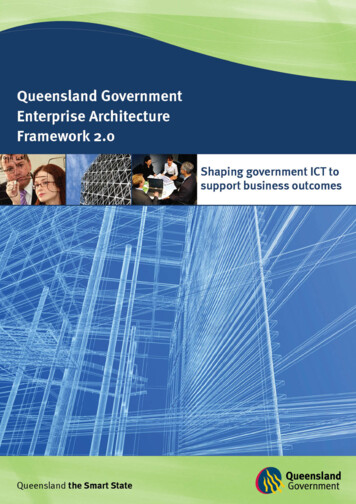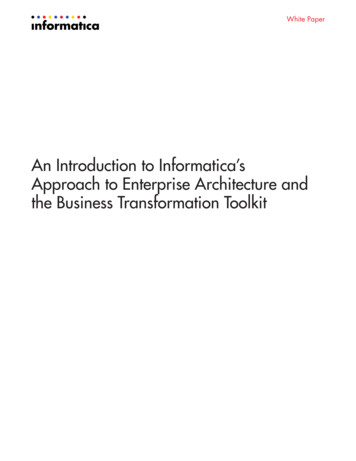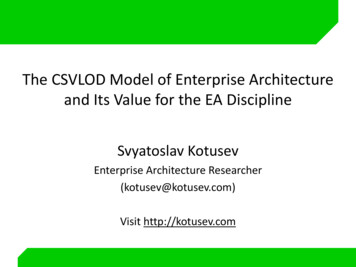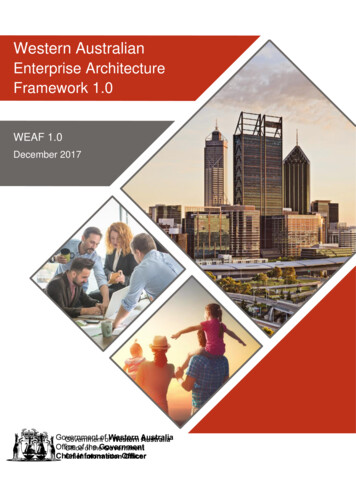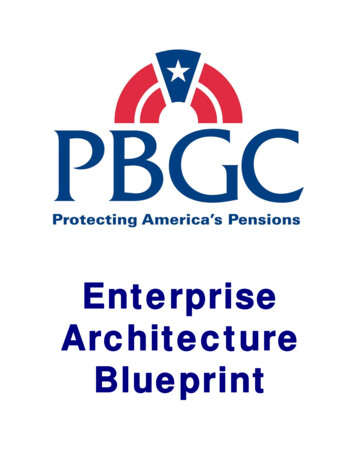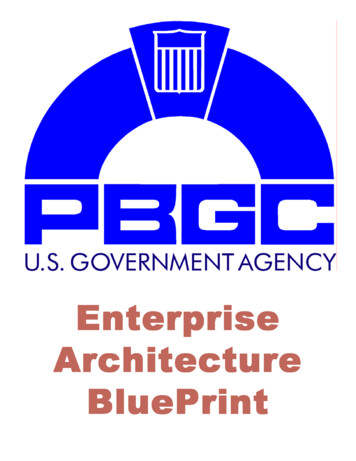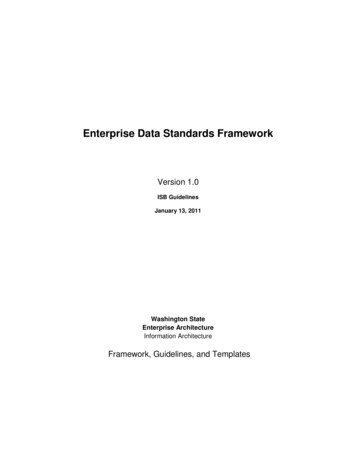
Transcription
World-ClassEnterprise Architecture:Framework Guidance andTOGAF 9 ExampleA White Paper by:The Open Group Adoption Strategies Working GroupApril 2010
World-Class Enterprise Architecture:Framework Guidance and TOGAF 9 ExampleCopyright 2010 The Open GroupAll rights reserved. No part of this publication may be reproduced, stored in aretrieval system, or transmitted, in any form or by any means, electronic,mechanical, photocopying, recording, or otherwise, without the priorpermission of the copyright owners.This White Paper is an informational document and does not form part of theTOGAF documentation set. Readers should note that this document has notbeen approved through the formal Open Group Standards Process and doesnot represent the formal consensus of The Open Group Architecture Forum.Boundaryless Information Flow and TOGAF are trademarks and MakingStandards Work , The Open Group , UNIX , and the “X” device areregistered trademarks of The Open Group in the United States and othercountries. All other trademarks are the property of their respective owners.All other brand, company, and product names are used for identificationpurposes only and may be trademarks that are the sole property of theirrespective owners.World-Class Enterprise Architecture:Framework Guidance and TOGAF 9 ExampleDocument No.:W103Published by The Open Group, April 2010Any comments relating to the material contained in this document may besubmitted to:The Open Group44 Montgomery St. #960San Francisco, CA 94104or by email to:ogpubs@opengroup.orgwww.opengroup.orgA White Paper Published by The Open Group2
World-Class Enterprise Architecture:Framework Guidance and TOGAF 9 ExampleTable of Contentswww.opengroup.orgExecutive Summary4Introduction5World-Class Enterprise Architecture Capabilities8TOGAF 9 to Implement World-Class Enterprise ArchitectureCapabilities9Worked Example11Appendix A: Overview of TOGAF 922Appendix B: Deliverable/Artifact Descriptions and Templates24Appendix C: Deliverable/Artifact to ADM Phase Mappings29Acknowledgements32About The Open Group32A White Paper Published by The Open Group3
World-Class Enterprise Architecture:Framework Guidance and TOGAF 9 ExampleBoundaryless Information Flow achieved through global interoperabilityin a secure, reliable, and timely mannerExecutive SummaryThis is the second part of a White Paper on adoption of world-class enterprisearchitecture.This document complements the TOGAF 9 specification by providing an approach tosuccessfully develop an enterprise architecture capability. This document will helpovercome common pitfalls when adopting TOGAF 9, and will ensure that anenterprise architecture function is focused on activities that provide recognized valueto an organization. Consequently, this document will lead to a: Fuller and more consistent use of the TOGAF 9 specification Higher success rate in the adoption and deployment of TOGAF 9 Faster and more cost-effective adoption and deployment of TOGAF 9www.opengroup.orgA White Paper Published by The Open Group4
World-Class Enterprise Architecture:Framework Guidance and TOGAF 9 ExampleIntroductionAbstractThe world is changing at a pace faster than ever experienced. Several trends in demographics, technology, theenvironment, globalization, public attitudes, and political institutions are driving Government 1 and Industryagendas as never before. In order to respond to the demands and needs of their stakeholders, organizations haveto launch ambitious business and technology programs in order to deliver significant value in a transparentmanner.Organizations need an enterprise architecture function as an integral capability in order to support thesetransformational programs. However, over the years, many organizations have attempted to set up enterprisearchitecture practices only to see them fail after a few years. These failures are due to several reasons, such asan inability to merge enterprise architecture processes with the other management processes – such as demandmanagement – within the organization, or the lack of authority for enterprise architects; for example, whenmaking strategic decisions or quality assuring programs and projects.In spite of these previous failures, organizations are again trying to set up enterprise architecture functions asthey have found that no other pragmatic alternatives exist.Enterprise architecture is thus here to stay.From a number of proprietary frameworks that have been developed by specific individuals or organizationsover the last few decades, enterprise architecture has now become main-stream, with the development andadoption of open frameworks such as The Open Group Architecture Framework (TOGAF 9).Organizations are deploying enterprise architecture functions at the heart of their operations in order tomaximize the impact, effectiveness, and therefore benefits of enterprise architecture. This central positionmeans that the consequences of enterprise architecture failure are also high. For this reason, organizations muststrive to develop world-class enterprise architecture from the outset.World-class enterprise architecture is the result of a mature and operational enterprise architecture function,within an organization, that leverages the entire suite of enterprise architecture capabilities. World-classenterprise architecture also provides a next-generation maturity model and roadmap that allows organizations toplan and monitor their progress on their particular enterprise architecture journey.Why is this Document Important?TOGAF 9 supports a modular, iterative, and incremental approach to enterprise architecture, both in terms ofhow architectures are developed and also in the way that architecture capability is developed. However, theadoption of a comprehensive set of enterprise architecture capabilities (as described in TOGAF 9) is a large andcomplex undertaking.Adopting TOGAF 9 is not an exercise that should typically be completed in a single step as organizations arelikely to prefer an incremental and evolutionary approach.This document complements the TOGAF 9 specification by providing an approach to successfully develop anenterprise architecture capability. This document will help overcome common pitfalls when adopting TOGAF1The Future and How to Think About It, Report by the Performance and Innovation Unit (PIU), UK Government, 1999www.opengroup.orgA White Paper Published by The Open Group5
World-Class Enterprise Architecture:Framework Guidance and TOGAF 9 Example9, and will ensure that an enterprise architecture function is focused on activities that provide recognized valueto an organization. Consequently, this document will lead to a: Fuller and more consistent use of the TOGAF 9 specification Higher success rate in the adoption and deployment of TOGAF 9 Faster and more cost-effective adoption and deployment of TOGAF 9How is this Document Structured?This document is the second of two parts: Part 1 looks at the adoption of world-class enterprise architecture. It identifies the capabilities that areneeded in order to successfully practice enterprise architecture, and explains how to prioritize them based ona number of factors such as business trends and drivers. Part 2 (this document) takes the world-class enterprise architecture approach forward and describes howTOGAF 9 should be used for the practical deployment of architecture capabilities. For each of the enterprisearchitecture capabilities identified in Part 1, this document describes in detail how TOGAF 9 can be used tohelp.The diagram below illustrates the five major steps of the world-class enterprise architecture approach.Figure 1: World-Class Enterprise Architecture ApproachThis document describes the fifth step of this approach, whereas the first four steps are described in Part 1: The World-Class Enterprise Architecture Capabilities section summarizes the architecture capabilitymodel that is described in Part 1. The TOGAF 9 to Implement World-Class Enterprise Architecture Capabilities section describes ourview of how organizations should adopt TOGAF 9 in order to develop world-class enterprise architecturecapabilities in their journey to achieve a world-class enterprise architecture function. The Worked Example section brings this approach to life. It walks through a fictional example of anorganization that is developing its enterprise architecture capability using TOGAF 9. Finally, Appendices A, B, and C provide an overview of the TOGAF 9 parts, descriptions of deliverablesand artifacts together with links to the actual templates, and mappings between these deliverables/artifactsand the Architecture Development Method (ADM) phases.www.opengroup.orgA White Paper Published by The Open Group6
World-Class Enterprise Architecture:Framework Guidance and TOGAF 9 ExampleLessons LearnedThroughout this White Paper, “Lessons Learned” sections will highlight the critical success factors that havebeen identified within each section.www.opengroup.orgA White Paper Published by The Open Group7
World-Class Enterprise Architecture:Framework Guidance and TOGAF 9 ExampleWorld-Class Enterprise Architecture CapabilitiesAn enterprise architecture capability, like any other business function, requires a number of elements such aspeople, process, technology, and information in order to operate effectively.Therefore, organizations can apply some of their generic practices and controls – for example, financial control,leadership, and the provision of human resource – to these architecture capabilities.However, other practices and controls for these architectural capabilities will be specific to the enterprisearchitecture function, as they will relate to the outcomes that enterprise architecture seeks to achieve.Although some enterprise architecture capabilities may only be deployable within a specific organization, ortype of organization – for example, due to a unique business model – most enterprise architecture capabilitiescan be deployed within any organization.The diagram below illustrates the capability model for world-class enterprise architecture that was developed inPart 1 of this document set. The rest of this document assumes an understanding of these capabilities and,furthermore, anticipates that a prioritization exercise that is based on valid business drivers has beenundertaken.Figure 2: World-Class Enterprise Architecture Capability ModelLessons LearnedKnowing “why” – TOGAF 9 provides a very rich assortment of tools and techniques. However, it can bedifficult to know where to begin. A prioritized set of capabilities, which are based on business drivers, will helpfocus on the specific aspects of TOGAF 9 that will provide the most value.www.opengroup.orgA White Paper Published by The Open Group8
World-Class Enterprise Architecture:Framework Guidance and TOGAF 9 ExampleTOGAF 9 to Implement World-Class Enterprise ArchitectureCapabilitiesTOGAF 9 contains a wealth of materials, too much to tackle at once, which need to be prioritized and tailoredin order to create value.The section describes our view of how organizations should adopt TOGAF 9 in order to develop world-classenterprise architecture capabilities in their journey to achieve a world-class enterprise architecture function.Note: An overview and descriptions for the TOGAF 9 parts are provided in Appendix A: Overview of TOGAF9.The table below shows mappings between TOGAF 9 parts and enterprise architecture capabilities, based on thearchitectural activities that need to be undertaken, and architecture deliverables and artifacts that need to beproduced, for the capability. Each of these mappings is specified as High (H), Medium (M), or Low (L), basedon whether the TOGAF 9 part is critical, desirable, or of low importance for the capability.EnterpriseStrategy &PortfolioManagementArchitecture RoadmappingArchitecture-SupportedProgram InceptionArchitectural Governance &Issue ManagementSolution ArchitectureReference e-SupportedSubcontractor GovernanceSubcontractor Collaboration & Integration Mgmt.Architecture StandardsStandardized ArchitectureDeliverablesStandardized Infrastructure& Tools for ArchitectureKnowledge Management forArchitecture ProductsConfiguration Mgmt. ofArchitecture ProductsFoundational ArchitectureCapabilityArchitecture Support forBusiness/IT Strategy Def.ProjectLevelArchitecture-Led EnterpriseStrategy DevelopmentProgramLevelUsingArchitectureto n and value of EA)MMLLLLLLLMMLLLLADM – PreliminaryLMMMLMLHLMLMLMLADM – A to DHHHHLHHHLLLMLLLADM – E and FHHHHMHLHMLLMLMLADM – G and HLMMMHHLMHMMMLHHArchitecture ContentFrameworkMMMHHHHHHHHHHHLArchtiecture PartitioningHMHLMLHHMHHMMHLEnterprise ContinuumHMHLLLHLLHMMHHLArchitecture RepositoryLLLHMMMMMHMMHHLReference Models –TRM & III-RMHLLMLMHLLMHMMLLArchitecture CapabilityFrameworkLLLLHLLMHHMLLMMTOGAF PartTable 1: World-Class Enterprise Architecture Capability to TOGAF Part Mappingswww.opengroup.orgA White Paper Published by The Open Group9
World-Class Enterprise Architecture:Framework Guidance and TOGAF 9 ExamplePart 1 of this documentation set describes how business trends and themes have been used to prioritizeenterprise architecture capabilities. Organizations then need to look at these prioritized capabilities in the table,and identify the complete set of TOGAF 9 architectural activities and collateral that they need to undertake orproduce respectively, in order to develop a world-class enterprise architecture function.For organizations that have already begun their TOGAF 9 implementation, the table may act as a referenceguide in order to ensure that their current direction is in line with industry best practice.Although the identification of TOGAF 9 activities and collateral that need to be undertaken or produced is anessential step in order to develop a world-class enterprise architecture function on the ground, the next step ofactually creating the first artifacts and deliverables represents a significant leap.Many enterprise architecture adoption initiatives founder at this point due to a lack of experience, and a lack ofunderstanding of the real purpose of various artifacts. In addition, there is often a pent-up demand forarchitecture work which leads to excessive time pressure that compounds the difficulties.By defining standardized content in terms of artifacts and deliverables, templates and best-practices can beleveraged in order to assist with these initial challenges.While the precise content will almost certainly need to be tuned to the precise needs of the initiative, an initialoutline of the end result is still an enormous help in bringing the TOGAF 9 specification to life, and in settingthe correct direction for the initial work.Note: Appendix A: Overview of TOGAF 9 provides templates for the standard TOGAF 9 deliverables andartifacts.Lessons LearnedBalancing content and process – A common pitfall is to get “lost in content”, producing extensive architecturedocumentation that is never actually used. Instead, it is important to balance content generation initiatives withwork on implementing best practices in areas such as Migration Planning and Implementation Governance. Acombined approach tackling both content (“thinking”) and process (“doing”) is very powerful.Not doing it all at once – Trying to take on too much initially leads to unfocused efforts which rarely make muchimpact. It is much better to choose a very small number of initiatives initially, and concentrate on doing themreally well. Additional content and techniques can then be introduced gradually, building on this proven success.Value of accelerators – Architecture work using TOGAF 9 follows a consistent pattern. Whilst every product isdifferent, there is no need to reinvent the wheel when creating basic artifacts and deliverables. Templates canaccelerate the effort, allowing architects to concentrate on value-adding insight rather than mundane documentcreation.Expectation setting – Stakeholders are often unfamiliar with architecture work, and unsure what the finaloutputs will look like. This may lead to a mismatch of expectations, with subsequent difficulties anddisappointment if the actual deliverables are not as imagined. By making use of templates, the architect caneducate stakeholders at a very early stage as to the likely format and content of the eventual outputs.Need for tailoring – While templates are useful, architecture work is not a mechanical activity. Delivering valueto stakeholders must take priority at all times. Therefore, in almost all real projects, templates have to be tailoredwith sections being added, removed, or customized to make the document more readable and relevant for itsintended purpose and audience.www.opengroup.orgA White Paper Published by The Open Group10
World-Class Enterprise Architecture:Framework Guidance and TOGAF 9 ExampleWorked ExampleThis section provides a complete worked example that steps through one (fictional) organization’s journey todevelop its enterprise architecture capability.BackgroundMike came out of the weekly meeting with his CIO, having been briefed on some strategic change that hadbeen mandated by the Board.He had joined Goldstore Bank six months ago as their Chief Enterprise Architect. The last 12 months at thebank, and indeed across the sector, had been the most challenging in living memory. The Bank is facing adeclining economy, heightened funding requirements (Basel II constraints, limited access throughsecuritization), and the increasing cost of client risk, which are all jeopardizing the old credit-based model thatdrove the Bank’s growth.Now, with all the day-to-day fire-fighting, and the general inertia of the Bank around new ways of working,any attempt to get architecture work underway seemed to be an uphill struggle.In this climate of crisis, how will architecture add value back to the Bank?Things had been different in Mike’s previous job where they had a mature architecture team working closelywith the business stakeholders and using best-practices from TOGAF 9.One of Mike’s first actions on joining Goldstore had been to get the team trained and certified in TOGAF 9, butunfortunately they had not had much chance to put it into practice yet.However, Mike now saw the “climate of crisis” as an opportunity to add value to the business while developinga world-class enterprise architecture capability here at Goldstore. He called his team together for a meeting.STEP 1: Identification of Business DriversIn 2008, the subprime crisis marked a clear stop to positive trends in the mortgage market, with an explosion infunding costs having a dramatic impact on mortgage profitability for the Bank. The Bank is now at acrossroads, with the Board calling for significant changes in order to remain successful over the next five years.As a top-performing retail bank, the Board has directed that they will have to rethink their business model andrevert to their historic deposit-based approach, leaving behind the credit-based model that they have relied uponover the past few years. To be successful in the future, the Bank must focus on deposits and provide the highestcapability to fund and transform those deposits into credits. A new deposit-based approach appears to beinevitable.The CIO has relayed to Mike that a key priority is the development of their sales, particularly by improvingtheir cross-selling capabilities, product bundling, and customer-based pricing models. They will also have tofind and attract new, lower-net-worth clients in order to increase volume.Rather than relying exclusively on cost reduction, the Bank needs to continue to develop sales.Reducing cost, primarily through the geographic consolidation of middle and back-offices as well as ITsystems, should be a target for the Bank. Nevertheless, in the context of the current financial crisis, cuttingcosts is not a sufficient measure by itself, due to high fixed costs and uncertain revenue streams.www.opengroup.orgA White Paper Published by The Open Group11
World-Class Enterprise Architecture:Framework Guidance and TOGAF 9 ExampleSo the key message from the CIO is that the Bank will need to create value in new ways, notably throughdifferentiation on offers and services.Mike recognized that there are significant challenges in aligning the business and IT around these drivers.It was true that Goldstore’s customer channels were far from ideal, and that they weakened its ability toeffectively cross-sell. The mainframe-based branch network had been upgraded in the 1990s, but little hadreally changed since then. Meanwhile, multiple different websites had been created for the different divisionsof the Bank, and call centers in South East Asia and Eastern Europe. None of these channels were particularlywell integrated, and customers often complained when information provided through one channel appeared tobe “lost” when they got in touch again via a different route. It was becoming unacceptable. Indeed feedbackfrom staff and customer surveys had proved that this issue was losing them business.The Bank’s CEO had set strategic objectives to double the profitability of the top 10% of customers, andachieve double-digit growth in new customers over the next five years. Projects were already being discussedacross the Bank, but progress was rather disjointed, and Mike knew that many of the project managers hadconcerns about whether everything would really come together as the Board anticipated.Bearing all this in mind, it seemed to Mike that the time was ripe to accelerate the development of Goldstore’senterprise architecture capabilities.STEP 2: Prioritization of Enterprise Architecture CapabilitiesMike’s team were enthusiastic about his suggestions for developing the bank’s enterprise architecture practice.Several of them dusted off their TOGAF 9 course notes and hung posters of the ADM and metamodel overtheir desks. One of the team even spent his weekend creating an intricate database for recording details of everyserver in the Bank. There were animated discussions in the canteen.Mike sighed. This enthusiasm was good, but he knew that much more was needed in order to make thearchitecture initiative a success. He organized an away-day for the team, to help prioritize their efforts. On theaway-day the team worked through a number of exercises to prioritize the enterprise architecture capabilitiesthat Goldstore Bank should develop first.They began with a baseline maturity assessment. Mike briefly presented the enterprise architecture capabilitiesmodel and then gave each team member a grid to fill in. They had five minutes to fill out their own grid, basedon their knowledge of the Bank, and then there was a 30-minute discussion to reach a combined answer. Mikewas deliberately keeping it very simple.The results looked like this:www.opengroup.orgA White Paper Published by The Open Group12
World-Class Enterprise Architecture:Framework Guidance and TOGAF 9 ExampleLevel 4(QuantitLevel 1Level 2Level 3ativelyLevel 5(Initial) (Managed) (Defined) Managed) (Optimizing)CharacteristicCore Business Capabilities for an ArchitecturePracticeXArchitecture at the Strategy and PortfolioManagement LevelArchitecture at the Program LevelXXArchitecture at the Project LevelXUsing Architecture to Manage Third-PartyContractorsXFoundational Architecture CapabilitiesXTable 2: Baseline Enterprise Architecture Maturity AssessmentSubsequent discussions confirmed these results. They agreed that the Bank was typical of a large bureaucratictype of organization. Projects were individually well run and managed, but typically progressed in silos thatrarely joined up to build the bigger picture. Also, insightful strategic directions were defined by the Board butoften got “lost” in the labyrinthine processes and procedures of the Bank. Program and portfolio managementwas based largely on gut-feel and office politics. And of course the team already knew that the architecturecapabilities were currently weak.After a brief coffee break, Mike set the team to work again in small groups, this time to consider theorganizational stakeholders for their architecture work. When the post-it notes were collated, the summary was:Relevant ArchitectureCapabilitiesStakeholderAttitude and ConcernsCEOArchitecture at theNot particularly interested in architecture per-se, butdoes want to see a focus on the differentiation on offers Strategy and PortfolioManagement Leveland services. Would like to see an extension of theBank’s activities to non-financial products (real estate,services, insurance, etc.).Frustrated at lack of progress on strategic targets andinitiatives.CIOStrong supporter.Reducing the level of reactive change and duplicationbetween projects.Processes need to be quickly designed andimplemented supported by technology to guarantee wellorganized client service.www.opengroup.orgArchitecture at theStrategy and PortfolioManagement LevelArchitecture at theProgram LevelA White Paper Published by The Open Group13
World-Class Enterprise Architecture:Framework Guidance and TOGAF 9 ExampleRelevant ArchitectureCapabilitiesStakeholderAttitude and ConcernsOperational ExecutivesArchitecture at theStrongly opposed to any “theoretical” architecture thatmight challenge their freedom to act and make decisions Project Levelwithin their own business unit.However, keen to get help with implementing their owncritical projects.Also concerned about how their KPI objectives forprofitability can be met.Program and ProjectManagementProfessionalsOpen to help from architecture work, as long as it doesnot stand in the way of project delivery.Often complain that they have trouble translatinggeneral strategic directions into concrete plans.Architecture at theProgram LevelArchitecture at theProject LevelTable 3: Enterprise Architecture Stakeholders MatrixFinally, the team considered the nature of the business need around sales growth, particularly with respect todifferentiation and cross-selling. Key architecture-related aspects were considered to be: A focus on understanding the processes within the business, as they will need to be quickly designed andimplemented; new sales offerings will likely be the result of bundling different financial products, andspeed-to-market will become an important factor Coordinating the efforts of disparate projects that are working on product-related initiatives throughout thebank Developing reference models for sales channels, and using them to build a consistent infrastructure so thatfuture channel developments could “slot-in” to a common framework Lack of money or opportunity for a major rewrite; rather, the architecture would have to progressincrementally via multiple projectsBased on all of these considerations, the team agreed that their focus for the next 6-12 months would be: Architecture at the strategy and portfolio management level Architecture at the program levelThe team felt that this approach would be the easiest to gain support for initially, as well as have the biggestimpact in terms of co-ordinating disparate individual projects which would improve the Bank’s sales growthand value creation initiative.The team also agreed to improve their own internal enterprise architecture practice capabilities as a by-productof this work, especially with regards to enterprise engagement, architecture standards and reference models,and architecture deliverable standardization.To conclude the morning’s activities, the team summarized these objectives on the enterprise architecturecapabilities maturity grid shown below:www.opengroup.orgA White Paper Published by The Open Group14
World-Class Enterprise Architecture:Framework Guidance and TOGAF 9 ExampleLevel 4(QuantitLevel 1Level 2Level 3ativelyLevel 5(Initial) (Managed) (Defined) Managed) (Optimizing)CharacteristicCore Business Capabilities for an Architecture PracticeXArchitecture at the Strategy and Portfolio ManagementLevelArchitecture at the Program LevelXOXOOOArchitecture at the Project LevelXUsing Architecture to Manage Third-Party ContractorsXFoundational Architecture CapabilitiesXOTable 4: Updated Enterprise Architecture Maturity AssessmentSTEP 3: Using TOGAF 9 for the ImplementationAfter lunch, the challenge was to consider how TOGAF 9 could help achieve the capability maturity objectivesset. The team refreshed their memory of the TOGAF 9 specification, and referred to the grid that crossreferenced the architecture capabilities to the TOGAF 9 areas.Initial efforts were rather over-ambitious, and Mike sent the team away to think again. “It’s better to pick just afew items and really make them work” he said. “Once the value of these first deliverables is proven, then it willbe much easier to extend the scope later.”After some further discussion, the following tasks and deliverables were prioritized:ADM A-D: An Architecture Vision for sales growth and value creation An Architecture Definition Document that needed to concentrate on the business, information systems,and data aspect areas of the Architecture Content Framework, and define Reference Models for thecustomer channelsADM E&F: An Architecture Roadmap, aimed at the Bank’s project and portfolio managers, which needed to showhow the Architecture Vision and Reference Model could be implemented incrementally via multiplecoordinated projectsAs they were packing up to go home, the team also agreed that, as a background activity, they would start todevelop their own foundational capabilities by collating the artifacts that they would develop into a simpleArchitecture Repository.STEP 4: Determining TOGAF 9 Templates and Best PracticesOver the following eight weeks, the architecture team set about the development of the architecture content. Acore team was assigned to develop the Architecture Roadmap, while others were tightly aligned
World-class enterprise architecture is the result of a mature and operational enterprise architecture function, within an organization, that leverages the entire suite of enterprise architecture capabilities. World-class enterprise architecture also provides a next-generation maturity model and roadmap that allows organizations to
